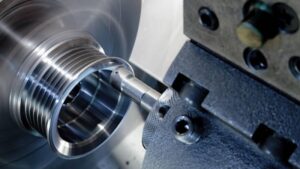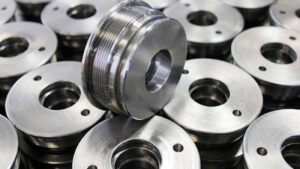Working with stainless steel can sometimes feel like a challenge if you don’t have the proper know-how. At the same time, it’s also one of the most rewarding materials to work with. Its toughness, resistance to corrosion, and sleek finish make it a popular choice across many industries. CNC machining stainless steel requires the right tools, techniques, and approach to avoid costly mistakes. With the right know-how, you can fabricate quality results, from sleek, high-strength parts to long-lasting components with precision. In this guide, we’ll walk through the best practices for CNC machining stainless steel and how you can get the best results like a pro.
What Is CNC Machining Stainless Steel?
CNC machining stainless steel is the process of shaping stainless steel into precise, custom parts using computer-controlled machines. CNC, which stands for Computer Numerical Control, takes the guesswork out of traditional machining. Instead of relying on manual operations, CNC machines follow pre-programmed commands to carve out detailed and accurate designs.
What makes CNC stainless steel stand out is its toughness and resistance to corrosion. It’s an alloy that combines steel with chromium and sometimes nickel or other elements, giving it strength and the ability to resist rusting even in harsh environments. This durability is why stainless steel is a popular material anywhere you need parts that can withstand wear and tear while still looking good over time.
Now, while CNC machining of stainless steel has many perks, it comes with its own set of challenges. Stainless steel is much more complicated than materials like aluminum or brass, which means machining requires more powerful machines and durable cutting tools. The hardness of the material can cause quick wear and tear on the cutting tools, leading to heat buildup and, in some cases, tool breakage. This is why operators must use proper speeds and feeds, select the right tools, and apply coolant effectively to keep the process smooth and prevent overheating.
How to CNC Stainless Steel Like a Pro

CNC diameter turning of stainless steel
If you’re dealing with CNC stainless steel, then you’ve probably figured out it’s not the easiest material to work with. Stainless steel is known for its toughness, which makes it tricky to machine. If you’re not using the proper techniques, tools, and settings, you could burn through cutting tools, end up with warped parts, or spend a ton of extra time fixing mistakes. But with the right know-how, you can machine stainless steel and get quality results every time.
Here’s what you need to know to make the machining process smooth, efficient, and precise:
Pick the Right Tools
Stainless steel is hard, so you need tools that can keep up with the job. Carbide cutting tools are the go-to choice because they are much more rigid than regular high-speed steel (HSS). HSS tools might be cheaper, but they’ll wear out faster and cost you more in the long run. Carbide tools last longer, cut cleaner, and reduce the headache of constantly switching out dull tools. Especially when machining stainless steel, you don’t want to skimp on your tooling.
Use the Right Speeds and Feeds
The most prominent mistake people make when machining stainless steel is running their machines too fast or too slow. If your machine is running too fast, the process will generate too much heat, and that’s a big problem. Heat can damage your tools and even warp the material. On the other hand, running too slow makes the process inefficient. Hence, as a general rule, keep your speeds lower (since stainless steel is hard) and increase your feed rate to maintain cutting efficiency. It’s all about balance, slow enough to avoid overheating but fast enough to keep productivity up.
Keep Vibration Under Control
The toughness of stainless steel makes vibration a real issue, and if you don’t deal with it, you’ll end up with poor surface finishes or, worse, broken tools. To reduce vibration, make sure your setup is stable. Tighten up your clamps and fixtures, and keep the workpiece as steady as possible. Another vital tip is to use shorter tool lengths when you can. The further your tool sticks out from the holder, the more likely it is to vibrate, which can lead to rough cuts and quicker tool wear.
Use Plenty of Coolants
Stainless steel tends to hold onto heat more than other materials, and this can lead to problems like tool wear, material warping, or poor surface finish. That’s where coolant comes in. A good flow of coolant during the machining process helps by keeping the material from overheating, lubricating the cutting tools, and washing away chips. You’ll get better cuts, your tools will last longer, and you’ll reduce the chances of damaging your parts.
Don’t Skip Roughing and Finishing Passes
CNC machining stainless steel takes patience. If you try to do everything in one pass, you’ll likely end up with poor results. Start with a roughing pass to remove most of the material, and then do a finishing pass to get that smooth, precise surface. This step-by-step approach makes it easier on your tools and gives you better final results.
Know Your Stainless Steel Grade
Stainless steel comes in different grades, and each machine a little different. For example, 304 and 316 are common but tricky because of their work-hardening properties, meaning they get tougher as you cut them. Knowing the grade of stainless steel you’re working with will help you adjust your approach for the best results.
Use Chip Breakers to Avoid Chip Build-Up
When cutting stainless steel, the chips don’t just fall away like they do with softer materials. Stainless steel chips tend to curl up and stick around, which can get in the way of your machining process and even damage your work. That’s why using chip breakers is a smart move. These small features on your cutting tool help break the chips into smaller pieces, which are easier to clear out of the way, improving your overall efficiency.
Applications of CNC Machining Stainless Steel

close up image of pile of round steel cylinders
CNC machining stainless steel has found its way into a range of industries thanks to the metal’s strength, durability, and resistance to corrosion. These qualities make it a top choice for manufacturing parts that need to last a long time while performing reliably under tough conditions.
Here’s where you’ll most often see stainless steel parts in action:
Aerospace Industry
Stainless steel parts are crucial in the aerospace industry. They can handle extreme temperatures and high pressure and resist corrosion while being considerably lightweight. Components like fasteners, landing gear components, and fuel nozzles rely on stainless steel’s toughness. CNC machining ensures these parts meet tight tolerances and high standards, ensuring nothing goes wrong mid-flight.
Medical Devices
The medical field needs materials that can be trusted in sensitive environments. Stainless steel is a go-to material for medical devices because it’s safe for use in the body (biocompatible), doesn’t rust when exposed to sterilization processes, and is durable. Surgical instruments, implants, and even parts like bone plates get fabricated from CNC-machined stainless steel. With CNC machining, medical manufacturers can guarantee that every cut and curve is spot-on, making sure these tools perform flawlessly.
Automotive Parts
In the automotive world, CNC machined stainless steel parts are commonly found in engine components, exhaust systems, and transmission parts. These parts need to withstand high heat, friction, and constant movement without breaking down. For example, parts like fuel injectors or brake calipers must meet exact standards to work correctly. As such, CNC machining delivers the accuracy needed, so these parts function without fail in fast-moving environments, helping cars run smoothly and safely.
Food Processing Equipment
Stainless steel is often used in food processing equipment because it doesn’t rust easily, is super easy to clean, and is strong enough to handle regular use without wearing out. Machines like mixers, grinders, and conveyor belts in food factories rely on stainless steel for its hygiene and durability. CNC machining plays a key role here by producing smooth surfaces on these parts, which makes them easier to clean and maintain.
Oil and Gas Industry
Stainless steel’s durability and anti-corrosion properties make it a favorite for offshore platforms and refineries. The oil and gas industry relies on stainless steel parts that can withstand high pressure, extreme temperatures, and corrosive environments. CNC machined stainless steel is used to fabricate these parts, such as valves, pumps, pipes, and fittings. In these conditions, equipment failure is not an option. CNC machining ensures that every piece of stainless steel equipment gets cut and formed precisely to avoid leaks or breakages, which could lead to costly downtime or even dangerous accidents.
Conclusion
CNC machining stainless steel combines the strength and durability of the material with the precision of modern manufacturing. This process delivers quality, accurate, and long-lasting parts, making it ideal for a wide range of industries. The ability to create parts with tight tolerances and smooth finishes ensures that stainless steel components perform reliably, even in harsh environments. Thus, CNC machining stainless steel remains the go-to solution for getting the job done right when you need rigid and precise parts.
At Zintilon, we use advanced CNC machining to create precise, durable parts tailored to your needs. Whether it’s a large-scale production or a custom order, we ensure top-notch results every time. Contact us today and let our expert team show you what a metal CNC machine can do for your next project!
